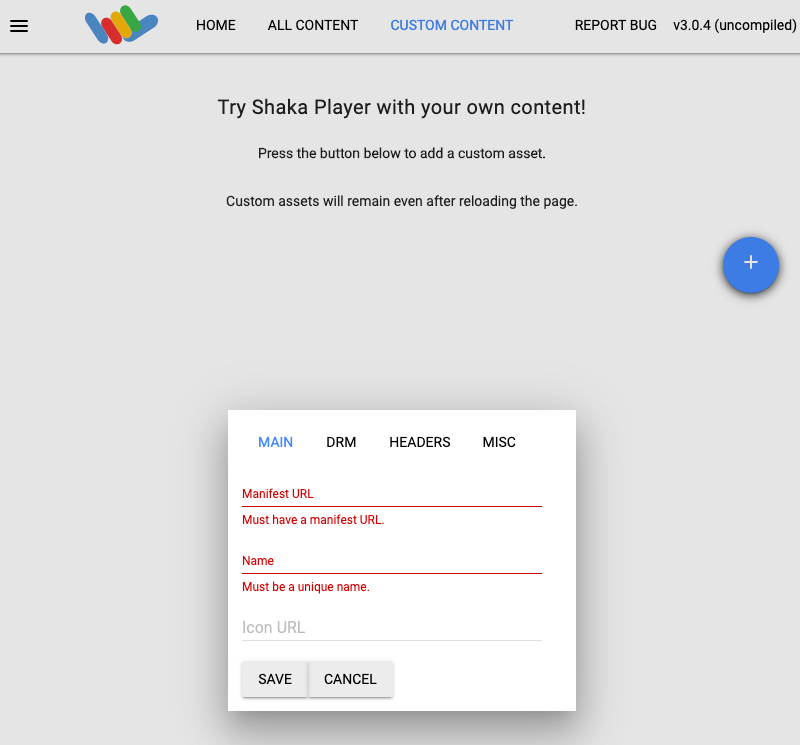本页介绍了如何创建插播广告并将其插入直播中。 可选广告是指可在您随时需要时替换主要直播内容的内容(例如,当输入源出现技术问题或需要隐藏输入源中的敏感内容时)。
设置您的 Google Cloud 项目和身份验证
如果您尚未创建 Google Cloud 项目和凭据,请参阅准备工作。将视频上传到 Cloud Storage 存储分区
- 在 Google Cloud 控制台中,前往 Cloud Storage 浏览器页面。
转到“Cloud Storage 浏览器”页面 - 点击存储分区的名称将其打开。
- 点击上传文件。
- 选择要从本地机器上传的视频文件。您可以使用时长为 60 秒的示例视频。
您的视频现已保存到 Cloud Storage 存储分区。
创建资产
素材资源是可与 Live Stream API 搭配使用的视频或图片。资源用于创建插播广告板频道活动。 您应在计划将素材资源用于插播广告之前很久就创建该素材资源,因为 API 需要时间来处理素材资源。如果资源在平板电脑事件执行时间后的两秒内未准备就绪,则会显示黑屏,直到资源准备就绪。
如需创建资源,请使用 projects.locations.assets.create 方法。以下示例会创建视频素材资源。
REST
在使用任何请求数据之前,请先进行以下替换:
PROJECT_NUMBER:您的 Google Cloud 项目编号;该编号位于 IAM 设置页面上的项目编号字段中LOCATION:用于创建资产的位置;请使用某个受支持的地区显示位置us-central1us-east1us-east4us-west1us-west2northamerica-northeast1southamerica-east1asia-east1asia-east2asia-south1asia-northeast1asia-southeast1australia-southeast1europe-north1europe-west1europe-west2europe-west3europe-west4
ASSET_ID:要创建的新资产的用户定义标识符。此值必须为 1-63 个字符,以[a-z0-9]开头和结尾,并且可以在字符之间包含短划线 (-)。例如my-asset。ASSET_URI:要使用的 Cloud Storage 存储桶中的视频的 URI,例如gs://my-bucket/my-video.mp4(请参阅支持的媒体格式)
如需发送您的请求,请展开以下选项之一:
您应该收到类似以下内容的 JSON 响应:
{
"name": "projects/PROJECT_NUMBER/locations/LOCATION/operations/OPERATION_ID",
"metadata": {
"@type": "type.googleapis.com/google.cloud.video.livestream.v1.OperationMetadata",
"createTime": CREATE_TIME,
"target": "projects/PROJECT_NUMBER/locations/LOCATION/assets/ASSET_ID",
"verb": "create",
"requestedCancellation": false,
"apiVersion": "v1"
},
"done": false
}
C#
如需了解如何安装和使用 Live Stream API 客户端库,请参阅 Live Stream API 客户端库。 如需了解详情,请参阅 Live Stream API C# API 参考文档。
如需向 Live Stream API 进行身份验证,请设置应用默认凭据。如需了解详情,请参阅为本地开发环境设置身份验证。
Go
如需了解如何安装和使用 Live Stream API 客户端库,请参阅 Live Stream API 客户端库。 如需了解详情,请参阅 Live Stream API Go API 参考文档。
如需向 Live Stream API 进行身份验证,请设置应用默认凭据。如需了解详情,请参阅为本地开发环境设置身份验证。
Java
如需了解如何安装和使用 Live Stream API 客户端库,请参阅 Live Stream API 客户端库。 如需了解详情,请参阅 Live Stream API Java API 参考文档。
如需向 Live Stream API 进行身份验证,请设置应用默认凭据。如需了解详情,请参阅为本地开发环境设置身份验证。
Node.js
如需了解如何安装和使用 Live Stream API 客户端库,请参阅 Live Stream API 客户端库。 如需了解详情,请参阅 Live Stream API Node.js API 参考文档。
如需向 Live Stream API 进行身份验证,请设置应用默认凭据。如需了解详情,请参阅为本地开发环境设置身份验证。
PHP
如需了解如何安装和使用 Live Stream API 客户端库,请参阅 Live Stream API 客户端库。 如需了解详情,请参阅 Live Stream API PHP API 参考文档。
如需向 Live Stream API 进行身份验证,请设置应用默认凭据。如需了解详情,请参阅为本地开发环境设置身份验证。
Python
如需了解如何安装和使用 Live Stream API 客户端库,请参阅 Live Stream API 客户端库。 如需了解详情,请参阅 Live Stream API Python API 参考文档。
如需向 Live Stream API 进行身份验证,请设置应用默认凭据。如需了解详情,请参阅为本地开发环境设置身份验证。
Ruby
如需了解如何安装和使用 Live Stream API 客户端库,请参阅 Live Stream API 客户端库。 如需了解详情,请参阅 Live Stream API Ruby API 参考文档。
如需向 Live Stream API 进行身份验证,请设置应用默认凭据。如需了解详情,请参阅为本地开发环境设置身份验证。
创建输入端点
如需创建输入端点,请使用 projects.locations.inputs.create 方法。
REST
在使用任何请求数据之前,请先进行以下替换:
PROJECT_NUMBER:您的 Google Cloud 项目编号;该编号位于 IAM 设置页面上的项目编号字段中LOCATION:创建输入端点的位置;请使用某个受支持的地区显示位置us-central1us-east1us-east4us-west1us-west2northamerica-northeast1southamerica-east1asia-east1asia-east2asia-south1asia-northeast1asia-southeast1australia-southeast1europe-north1europe-west1europe-west2europe-west3europe-west4
INPUT_ID:要创建的新输入端点(您将输入流发送到该端点)的用户定义标识符。此值必须为 1-63 个字符,以[a-z0-9]开头和结尾,并且可以在字符之间包含短划线 (-)。例如my-input。
如需发送您的请求,请展开以下选项之一:
您应该收到类似以下内容的 JSON 响应:
{
"name": "projects/PROJECT_NUMBER/locations/LOCATION/operations/OPERATION_ID",
"metadata": {
"@type": "type.googleapis.com/google.cloud.video.livestream.v1.OperationMetadata",
"createTime": CREATE_TIME,
"target": "projects/PROJECT_NUMBER/locations/LOCATION/inputs/INPUT_ID",
"verb": "create",
"requestedCancellation": false,
"apiVersion": "v1"
},
"done": false
}
C#
如需了解如何安装和使用 Live Stream API 客户端库,请参阅 Live Stream API 客户端库。 如需了解详情,请参阅 Live Stream API C# API 参考文档。
如需向 Live Stream API 进行身份验证,请设置应用默认凭据。如需了解详情,请参阅为本地开发环境设置身份验证。
Go
如需了解如何安装和使用 Live Stream API 客户端库,请参阅 Live Stream API 客户端库。 如需了解详情,请参阅 Live Stream API Go API 参考文档。
如需向 Live Stream API 进行身份验证,请设置应用默认凭据。如需了解详情,请参阅为本地开发环境设置身份验证。
Java
如需了解如何安装和使用 Live Stream API 客户端库,请参阅 Live Stream API 客户端库。 如需了解详情,请参阅 Live Stream API Java API 参考文档。
如需向 Live Stream API 进行身份验证,请设置应用默认凭据。如需了解详情,请参阅为本地开发环境设置身份验证。
Node.js
如需了解如何安装和使用 Live Stream API 客户端库,请参阅 Live Stream API 客户端库。 如需了解详情,请参阅 Live Stream API Node.js API 参考文档。
如需向 Live Stream API 进行身份验证,请设置应用默认凭据。如需了解详情,请参阅为本地开发环境设置身份验证。
PHP
如需了解如何安装和使用 Live Stream API 客户端库,请参阅 Live Stream API 客户端库。 如需了解详情,请参阅 Live Stream API PHP API 参考文档。
如需向 Live Stream API 进行身份验证,请设置应用默认凭据。如需了解详情,请参阅为本地开发环境设置身份验证。
Python
如需了解如何安装和使用 Live Stream API 客户端库,请参阅 Live Stream API 客户端库。 如需了解详情,请参阅 Live Stream API Python API 参考文档。
如需向 Live Stream API 进行身份验证,请设置应用默认凭据。如需了解详情,请参阅为本地开发环境设置身份验证。
Ruby
如需了解如何安装和使用 Live Stream API 客户端库,请参阅 Live Stream API 客户端库。 如需了解详情,请参阅 Live Stream API Ruby API 参考文档。
如需向 Live Stream API 进行身份验证,请设置应用默认凭据。如需了解详情,请参阅为本地开发环境设置身份验证。
获取输入源端点详细信息
如需获取输入源端点的详细信息,请使用 projects.locations.inputs.get 方法。
REST
在使用任何请求数据之前,请先进行以下替换:
PROJECT_NUMBER:您的 Google Cloud 项目编号;该编号位于 IAM 设置页面上的项目编号字段中LOCATION:输入端点所在的位置;请使用某个受支持的地区显示位置us-central1us-east1us-east4us-west1us-west2northamerica-northeast1southamerica-east1asia-east1asia-east2asia-south1asia-northeast1asia-southeast1australia-southeast1europe-north1europe-west1europe-west2europe-west3europe-west4
INPUT_ID:用户定义的输入端点标识符
如需发送您的请求,请展开以下选项之一:
您应该收到类似以下内容的 JSON 响应:
{
"name": "projects/PROJECT_NUMBER/locations/LOCATION/inputs/INPUT_ID",
"createTime": CREATE_TIME,
"updateTime": UPDATE_TIME,
"type": "RTMP_PUSH",
"uri": "INPUT_STREAM_URI", # For example, "rtmp://1.2.3.4/live/b8ebdd94-c8d9-4d88-a16e-b963c43a953b",
"tier": "HD"
}
C#
如需了解如何安装和使用 Live Stream API 客户端库,请参阅 Live Stream API 客户端库。 如需了解详情,请参阅 Live Stream API C# API 参考文档。
如需向 Live Stream API 进行身份验证,请设置应用默认凭据。如需了解详情,请参阅为本地开发环境设置身份验证。
Go
如需了解如何安装和使用 Live Stream API 客户端库,请参阅 Live Stream API 客户端库。 如需了解详情,请参阅 Live Stream API Go API 参考文档。
如需向 Live Stream API 进行身份验证,请设置应用默认凭据。如需了解详情,请参阅为本地开发环境设置身份验证。
Java
如需了解如何安装和使用 Live Stream API 客户端库,请参阅 Live Stream API 客户端库。 如需了解详情,请参阅 Live Stream API Java API 参考文档。
如需向 Live Stream API 进行身份验证,请设置应用默认凭据。如需了解详情,请参阅为本地开发环境设置身份验证。
Node.js
如需了解如何安装和使用 Live Stream API 客户端库,请参阅 Live Stream API 客户端库。 如需了解详情,请参阅 Live Stream API Node.js API 参考文档。
如需向 Live Stream API 进行身份验证,请设置应用默认凭据。如需了解详情,请参阅为本地开发环境设置身份验证。
PHP
如需了解如何安装和使用 Live Stream API 客户端库,请参阅 Live Stream API 客户端库。 如需了解详情,请参阅 Live Stream API PHP API 参考文档。
如需向 Live Stream API 进行身份验证,请设置应用默认凭据。如需了解详情,请参阅为本地开发环境设置身份验证。
Python
如需了解如何安装和使用 Live Stream API 客户端库,请参阅 Live Stream API 客户端库。 如需了解详情,请参阅 Live Stream API Python API 参考文档。
如需向 Live Stream API 进行身份验证,请设置应用默认凭据。如需了解详情,请参阅为本地开发环境设置身份验证。
Ruby
如需了解如何安装和使用 Live Stream API 客户端库,请参阅 Live Stream API 客户端库。 如需了解详情,请参阅 Live Stream API Ruby API 参考文档。
如需向 Live Stream API 进行身份验证,请设置应用默认凭据。如需了解详情,请参阅为本地开发环境设置身份验证。
找到 uri 字段,然后复制返回的 INPUT_STREAM_URI 以供稍后在发送输入流部分中使用。
创建频道
如需创建渠道,请使用 projects.locations.channels.create 方法。以下示例会创建一个生成 HLS 直播的频道。直播包含单个高清 (1280x720) 转码版本。
REST
在使用任何请求数据之前,请先进行以下替换:
PROJECT_NUMBER:您的 Google Cloud 项目编号;该编号位于 IAM 设置页面上的项目编号字段中LOCATION:创建渠道的位置;请使用某个受支持的地区显示位置us-central1us-east1us-east4us-west1us-west2northamerica-northeast1southamerica-east1asia-east1asia-east2asia-south1asia-northeast1asia-southeast1australia-southeast1europe-north1europe-west1europe-west2europe-west3europe-west4
CHANNEL_ID:要创建的渠道的用户定义标识符;此值必须为 1-63 个字符,以[a-z0-9]开头和结尾,并且可以在字符之间包含短划线 (-)。INPUT_ID:用户定义的输入端点标识符BUCKET_NAME:您创建的用于存放直播清单和分段文件的 Cloud Storage 存储桶的名称
如需发送您的请求,请展开以下选项之一:
您应该收到类似以下内容的 JSON 响应:
{
"name": "projects/PROJECT_NUMBER/locations/LOCATION/operations/OPERATION_ID",
"metadata": {
"@type": "type.googleapis.com/google.cloud.video.livestream.v1.OperationMetadata",
"createTime": CREATE_TIME,
"target": "projects/PROJECT_NUMBER/locations/LOCATION/channels/CHANNEL_ID",
"verb": "create",
"requestedCancellation": false,
"apiVersion": "v1"
},
"done": false
}
C#
如需了解如何安装和使用 Live Stream API 客户端库,请参阅 Live Stream API 客户端库。 如需了解详情,请参阅 Live Stream API C# API 参考文档。
如需向 Live Stream API 进行身份验证,请设置应用默认凭据。如需了解详情,请参阅为本地开发环境设置身份验证。
Go
如需了解如何安装和使用 Live Stream API 客户端库,请参阅 Live Stream API 客户端库。 如需了解详情,请参阅 Live Stream API Go API 参考文档。
如需向 Live Stream API 进行身份验证,请设置应用默认凭据。如需了解详情,请参阅为本地开发环境设置身份验证。
Java
如需了解如何安装和使用 Live Stream API 客户端库,请参阅 Live Stream API 客户端库。 如需了解详情,请参阅 Live Stream API Java API 参考文档。
如需向 Live Stream API 进行身份验证,请设置应用默认凭据。如需了解详情,请参阅为本地开发环境设置身份验证。
Node.js
如需了解如何安装和使用 Live Stream API 客户端库,请参阅 Live Stream API 客户端库。 如需了解详情,请参阅 Live Stream API Node.js API 参考文档。
如需向 Live Stream API 进行身份验证,请设置应用默认凭据。如需了解详情,请参阅为本地开发环境设置身份验证。
PHP
如需了解如何安装和使用 Live Stream API 客户端库,请参阅 Live Stream API 客户端库。 如需了解详情,请参阅 Live Stream API PHP API 参考文档。
如需向 Live Stream API 进行身份验证,请设置应用默认凭据。如需了解详情,请参阅为本地开发环境设置身份验证。
Python
如需了解如何安装和使用 Live Stream API 客户端库,请参阅 Live Stream API 客户端库。 如需了解详情,请参阅 Live Stream API Python API 参考文档。
如需向 Live Stream API 进行身份验证,请设置应用默认凭据。如需了解详情,请参阅为本地开发环境设置身份验证。
Ruby
如需了解如何安装和使用 Live Stream API 客户端库,请参阅 Live Stream API 客户端库。 如需了解详情,请参阅 Live Stream API Ruby API 参考文档。
如需向 Live Stream API 进行身份验证,请设置应用默认凭据。如需了解详情,请参阅为本地开发环境设置身份验证。
创建频道
如需启动频道,请使用 projects.locations.channels.start 方法。
REST
在使用任何请求数据之前,请先进行以下替换:
PROJECT_NUMBER:您的 Google Cloud 项目编号;该编号位于 IAM 设置页面上的项目编号字段中LOCATION:频道所在的地理位置;请使用支持的地区之一显示位置us-central1us-east1us-east4us-west1us-west2northamerica-northeast1southamerica-east1asia-east1asia-east2asia-south1asia-northeast1asia-southeast1australia-southeast1europe-north1europe-west1europe-west2europe-west3europe-west4
CHANNEL_ID:用户定义的渠道标识符
如需发送您的请求,请展开以下选项之一:
您应该收到类似以下内容的 JSON 响应:
{
"name": "projects/PROJECT_NUMBER/locations/LOCATION/operations/OPERATION_ID",
"metadata": {
"@type": "type.googleapis.com/google.cloud.video.livestream.v1.OperationMetadata",
"createTime": CREATE_TIME,
"target": "projects/PROJECT_NUMBER/locations/LOCATION/channels/CHANNEL_ID",
"verb": "start",
"requestedCancellation": false,
"apiVersion": "v1"
},
"done": false
}
C#
如需了解如何安装和使用 Live Stream API 客户端库,请参阅 Live Stream API 客户端库。 如需了解详情,请参阅 Live Stream API C# API 参考文档。
如需向 Live Stream API 进行身份验证,请设置应用默认凭据。如需了解详情,请参阅为本地开发环境设置身份验证。
Go
如需了解如何安装和使用 Live Stream API 客户端库,请参阅 Live Stream API 客户端库。 如需了解详情,请参阅 Live Stream API Go API 参考文档。
如需向 Live Stream API 进行身份验证,请设置应用默认凭据。如需了解详情,请参阅为本地开发环境设置身份验证。
Java
如需了解如何安装和使用 Live Stream API 客户端库,请参阅 Live Stream API 客户端库。 如需了解详情,请参阅 Live Stream API Java API 参考文档。
如需向 Live Stream API 进行身份验证,请设置应用默认凭据。如需了解详情,请参阅为本地开发环境设置身份验证。
Node.js
如需了解如何安装和使用 Live Stream API 客户端库,请参阅 Live Stream API 客户端库。 如需了解详情,请参阅 Live Stream API Node.js API 参考文档。
如需向 Live Stream API 进行身份验证,请设置应用默认凭据。如需了解详情,请参阅为本地开发环境设置身份验证。
PHP
如需了解如何安装和使用 Live Stream API 客户端库,请参阅 Live Stream API 客户端库。 如需了解详情,请参阅 Live Stream API PHP API 参考文档。
如需向 Live Stream API 进行身份验证,请设置应用默认凭据。如需了解详情,请参阅为本地开发环境设置身份验证。
Python
如需了解如何安装和使用 Live Stream API 客户端库,请参阅 Live Stream API 客户端库。 如需了解详情,请参阅 Live Stream API Python API 参考文档。
如需向 Live Stream API 进行身份验证,请设置应用默认凭据。如需了解详情,请参阅为本地开发环境设置身份验证。
Ruby
如需了解如何安装和使用 Live Stream API 客户端库,请参阅 Live Stream API 客户端库。 如需了解详情,请参阅 Live Stream API Ruby API 参考文档。
如需向 Live Stream API 进行身份验证,请设置应用默认凭据。如需了解详情,请参阅为本地开发环境设置身份验证。
发送输入流
如果您使用 ffmpeg 发送测试流,请打开一个新的终端窗口。运行以下命令,使用获取输入端点详情部分中的 INPUT_STREAM_URI:
ffmpeg -re -f lavfi -i "testsrc=size=1280x720 [out0]; sine=frequency=500 [out1]" \
-acodec aac -vcodec h264 -f flv INPUT_STREAM_URI
播放直播
如需在 Shaka Player 中播放生成的媒体文件,请完成以下步骤:
- 请将 Cloud Storage 存储分区设为可公开读取。
- 如需在 Cloud Storage 存储分区上启用跨域资源共享 (CORS),请执行以下操作:
- 创建一个包含以下代码的 JSON 文件:
[ { "origin": ["https://shaka-player-demo.appspot.com/"], "responseHeader": ["Content-Type", "Range"], "method": ["GET", "HEAD"], "maxAgeSeconds": 3600 } ] -
将
JSON_FILE_NAME替换为您在上一步中创建的 JSON 文件的名称,然后运行以下命令:gcloud storage buckets update gs://BUCKET_NAME --cors-file=JSON_FILE_NAME.json
- 创建一个包含以下代码的 JSON 文件:
- 在 Cloud Storage 存储桶中,找到生成的文件。在该文件的公开访问权限列中,点击复制网址。
- 导航到在线直播播放器 Shaka Player。
- 点击顶部导航栏中的自定义内容。
- 点击 + 按钮。
将文件的公开网址粘贴到清单网址框中。

在名称框中输入一个名称。
点击保存。
点击播放。
您应该会看到测试模式以直播形式播放。

创建频道活动
如需创建频道活动,请使用 projects.locations.channels.events.create 方法。以下示例将插播广告作为频道活动插入直播中。
如果平板电脑素材资源未就绪(在活动执行开始后两秒内),则会显示黑屏,直到平板电脑素材资源就绪为止。
REST
在使用任何请求数据之前,请先进行以下替换:
PROJECT_NUMBER:您的 Google Cloud 项目编号;该编号位于 IAM 设置页面上的项目编号字段中LOCATION:频道所在的地理位置;请使用支持的地区之一显示位置us-central1us-east1us-east4us-west1us-west2northamerica-northeast1southamerica-east1asia-east1asia-east2asia-south1asia-northeast1asia-southeast1australia-southeast1europe-north1europe-west1europe-west2europe-west3europe-west4
CHANNEL_ID:用户定义的渠道标识符EVENT_ID:用户定义的事件标识符ASSET_ID:用户定义的平板电脑资源标识符
如需发送您的请求,请展开以下选项之一:
您应该收到类似以下内容的 JSON 响应:
{
"name": "projects/PROJECT_NUMBER/locations/LOCATION/channels/CHANNEL_ID/events/EVENT_ID",
"createTime": CREATE_TIME,
"updateTime": UPDATE_TIME,
"slate": {
"duration": "60s",
"asset": "projects/PROJECT_NUMBER/locations/LOCATION/assets/ASSET_ID"
},
"executeNow": "true",
"state": "PENDING"
}
查看直播,确认已插入板书。您还可以检查事件的 state 是否已设置为 SUCCEEDED(请参阅获取渠道事件详细信息)。
如需创建长时间运行的板块,请从 slate 对象中移除 duration 字段。如需移除长时间播放的插播广告,请创建返回节目频道事件。

